 |
 |
| Home | Welcome | What's New | Site Map | Glossary | Weather Doctor Amazon Store | Book Store | Accolades | Email Us |
 | ||||||||||||||||||||||||||||||||||||||||||||||||||||||||||||||||||||||||||||||||
Weather Almanac for June 2010VOLCANO WEATHERThe recent eruptions, which began on 20 March 2010, of the Eyjafjallajökull volcano in Iceland have been causing major disruptions in air travel across Europe for several months as of this writing. For many, questions have arisen concerning its impact on weather and climate. So this month, I will bump my original topic planned for this month’s Almanac and will look into what we know about volcano weather. Volcanoes are erupting in many other areas of the globe concurrent with Eyjafjallajökull (over 50 named volcanoes are currently active), but most are non-explosive like Hawaii’s Kilauea, which emits lava onto the surface and does not inject volcanic materials — ash, dust and gas — to any appreciable height into the atmosphere. A high percentage of volcanic activity on Earth is occurring under the sea along the margins of undersea tectonic plates that are either converging or diverging. A few others above the sea, such as Soufriere Hills on Montserrat in the West Indies, intermittently erupt and emit ash clouds into the atmosphere but do so without the quantity of materials currently being emitted from Eyjafjallajökull. 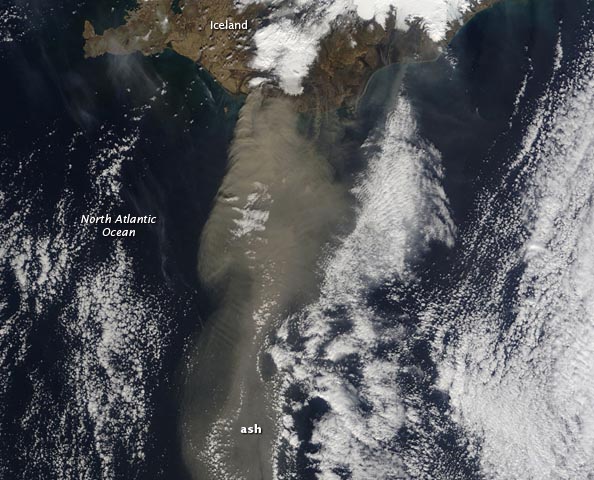 Iceland’s Eyjafjallajökull volcano on April 19, 2010. |
||||||||||||||||||||||||||||||||||||||||||||||||||||||||||||||||||||||||||||||||
|
VEI |
Description |
Plume Height |
Volume |
Classification |
How often |
Example |
|
0 |
non-explosive |
< 100 m |
1000s m3 |
Hawaiian |
daily |
Kilauea |
|
1 |
gentle |
100-1000 m |
10 000s m3 |
Haw/Strombolian |
daily |
Stromboli |
|
2 |
explosive |
1-5 km |
1 000 000s m3 |
Strom/Vulcanian |
weekly |
Galeras, 1992 |
|
3 |
severe |
3-15 km |
10 000 000s m3 |
Vulcanian |
yearly |
Ruiz, 1985 |
|
4 |
cataclysmic |
10-25 km |
100 000 000s m3 |
Vulc/Plinian |
10s of years |
Galunggung, 1982 |
|
5 |
paroxysmal |
> 25 km |
1 km3 |
Plinian |
100s of years |
St. Helens, 1981 |
|
6 |
colossal |
> 25 km |
10s km3 |
Plin/Ultra-Plinian |
100s of years |
Krakatau, 1883 |
|
7 |
super-colossal |
> 25 km |
100s km3 |
Ultra-Plinian |
1000s of years |
Tambora, 1815 |
|
8 |
mega-colossal |
> 25 km |
1 000s km3 |
Ultra-Plinian |
10 000s of years |
Yellowstone, 2 Ma |
While all explosive volcanoes have some effects on the weather, if only on a local level, it appears that an eruption with a VEI of 5 or more is needed to produce a longer term impact on global weather/climate. Where the volcano erupts also has a bearing on its atmospheric impact. Those erupting in the equatorial zones are more likely to have global implications than those erupting at high latitudes such as Iceland. Such large-scale influences often last several years.
| I have often noted that we really don’t have a good time-scale term for such influences. An influence that affects immediate conditions can be said to influence the weather, those that last several months can be called seasonal influences. But after that, terminology jumps into climate influences that really should only apply to changes manifesting over decades. Those non-permanent changes that occur over time frames from a few years to a few decades, which would include the ENSO oscillations, should really have its own distinct term. |
Among the first to comment on the impact of volcanoes on the weather was the American Founding Father and pioneering scientist Benjamin Franklin. The triggering event was the great eruption (VEI = 6) on 8 June 1783, of Laki , located in south central Iceland. While serving as ambassador to France, Franklin noticed: “During several of the summer months of the year 1783, when the effect of the sun's rays to heat the earth in these northern regions should have been greater, there existed a constant fog over all Europe, and a great part of North America. This fog was of a permanent nature; it was dry, and the rays of the sun seemed to have little effect towards dissipating it, as they easily do a moist fog, arising from water.”
The summer sun’s rays had been so strongly diminished that “when collected in the focus of a burning glass they would scarce kindle brown paper.” The following winter was among the harshest of the times. “The cause of this universal fog is not yet ascertained…,” Franklin noted, but he speculated that it might be “the vast quantity of smoke, long continuing, to issue during the summer from Hekla in Iceland, and that other volcano which arose out of the sea near that island [Skaptar Jökull], which smoke might be spread by various winds, over the northern part of the world…” Actually, it was nearby Laki (72 km (45 miles) to the east of Hekla) that had erupted, not Hekla which had erupted the late 1760s (VEI=4).
He concluded the paper: “It seems however worth the enquiry, whether other hard winters, recorded in history, were preceded by similar permanent and widely extended summer fogs.”
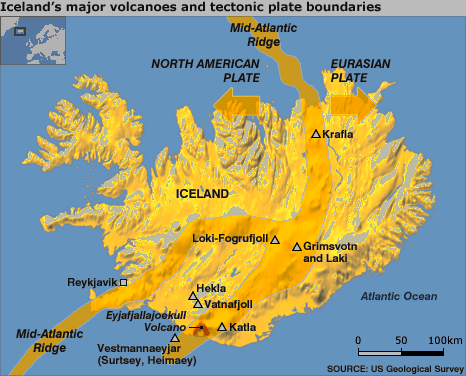
Whether or not Laki was the sole influence on the colder winter, we, like Franklin, can only conjecture at this time since another major volcanic eruption also occurred that year: Japan’s Mount Asama (VEI=4). According to Hubert Lamb’s dust veil index (DVI) of volcanic eruptions, Laki and Skaptar Jökull combined for a 700 DVI and Asama an additional 300. On this scale, Krakatau rated as 1000 and Tambora as 3000.
Laki had an immediate effect on Europe, however. An extensive and persistent high pressure cell extending over Iceland established northwesterly winds over western Europe that brought the Laki ash cloud across the continent. Within days of the eruption’s commencement, a poisonous cloud of sulfur dioxide and sulfuric acid drifted across Bergen, Norway. It then spread across central Europe to Prague in Bohemia (now the Czech Republic) by 17 June. As the winds altered the volcanic plume’s course, it crossed Berlin on 18 June, Paris by the 20, Le Havre on the 22nd, and then Great Britain by 23 June.
The dry fog obscured visibility to the extent that boats stayed in port, unable to navigate. Gilbert White in Natural History of Selborne (England) described the dull sun as “particularly lurid and blood-coloured….” The deadly cloud persisted for months engulfing much of Western Europe. A recent study of the impacts in this region estimated the annual mean surface cooling 2–3 years following the initial Laki eruption to be about −1.3C degrees (-2.3 F deg).
The winters that followed these two eruptions were among the coldest in memory. In North America, the winter of 1783-84 brought the longest stretch of below zero Fahrenheit temperatures to New England and the greatest accumulation of snow in parts of New Jersey. Enough ice accumulated in Charleston Harbor for iceskating. Chesapeake Bay had its longest ice cover on record. The Mississippi River was frozen at New Orleans and ice flowed into the Gulf of Mexico. Conditions were as bad in Europe. Naturalist Gilbert White at Selborne, Hampshire, England observed 28 consecutive days of frost.
The meteorological impact of Laki continued to be significant for several years, bringing extreme weather in Europe. In France, the impact of the sequence of weather extremes may have contributed to the French Revolution in 1789 by disrupting the economy.
When volcanoes blast ash and other volcanic materials high into the atmosphere, they can influence the weather conditions for several years. The biggest volcanic eruptions have the potential to lower the Earth’s temperature for a few years because the sulfuric gases they produce can absorb and reflect back the sun’s radiation. Among the important factors that determine whether a volcanic eruption disrupts the normal conditions include:
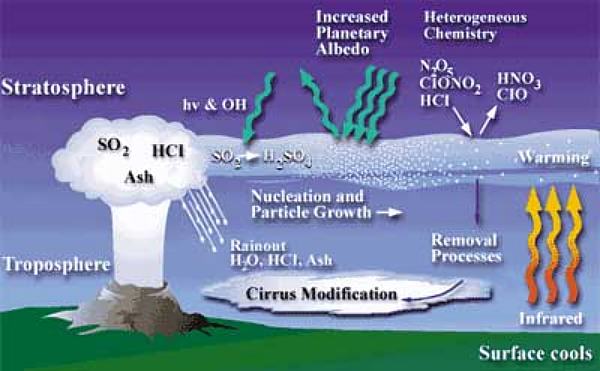
While a volcanic plume contains large quantities of carbon dioxide and water vapor, both so-called “greenhouse gases,” the prime chemicals for causing surface temperature depressions around the globe are the sulfur compounds, notably sulfur dioxide and sulfuric acid. These sulfur molecules form aerosols, which can attract water vapor, produce a haze high in the stratosphere that reflects or absorbs incoming sunlight, and thus reduce surface temperatures. It appears that volcanoes that emit more sulfur compounds have a greater impact on those with lesser sulfur emissions. The June 1991 eruption of Mount Pinatubo, for example, blew 22 million tons of sulfur dioxide into the high atmosphere.
The particulate ash comprised of various minerals can also contribute to the high-altitude haze. Those particles having a size equivalent to sand grains or larger fall out of the air rapidly and generally close to the volcano. They may have considerable local impacts but are not important on the global scale. Smaller ash dust entering the lower atmosphere can persist for days but usually no longer, being removed by washout from rain and snow or gravitational deposition. But if the eruption injects these minute particles into the stratosphere, they can remain suspended for weeks, months, or even years before finally settling to earth. While in suspension, they can block incoming sunlight and cause cooling.
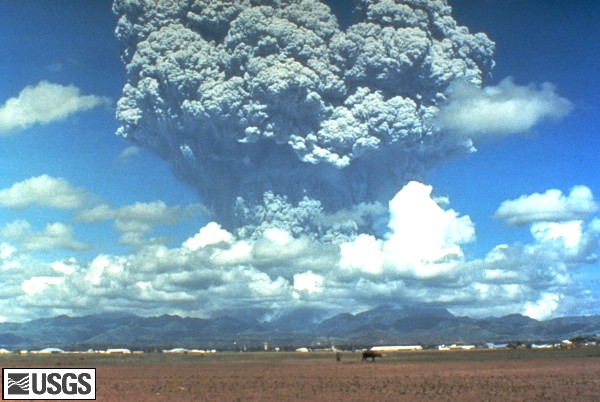
Combining the small particles with reflective hazes of sulfur droplets, the resulting stratospheric haze layer can spread on the global wind systems across the planet. Observations indicate these hazes can remain effective for as long as two-three years after a major sulfur-bearing eruption. The resulting reduction in solar radiation at the surface causes significant cooling of the Earth. The Philippines’ Mt Pinatubo and Mexico’s El Chichon (VEI = 5) eruptions caused a measured drop in sunlight reaching the surface of greater than 10 percent. We know by comprehensive observations that the eruption of Mt Pinatubo in 1991 reduced the global temperatures by about 0.6 Celsius degrees (1.0 Fahrenheit degree) until 1993. El Chichon had a similar effect.
The injection of carbon dioxide and water may produce a short-term warming effect that is masked and dominated by the cooling due to the sulfur compounds. Ongoing volcanism is estimated to account for 3 percent of the annual emissions of carbon dioxide in the atmosphere, about 32 times less than total annual anthropogenic sources. The water generally condenses out of the atmosphere as rain in hours or days after release, and the carbon dioxide quickly dissolves in the oceans or is absorbed by plants.
Second in importance to ash composition, is the height to which the plume is injected into the sky. Emissions reaching 10,000 metres (33,000 ft) or higher usually have a global impact on long-term weather. Injection to these stratospheric heights helps ensure that the sulfur and minute dust particles remain suspended in the atmosphere for a considerable length of time. Mt Pinatubo’s most powerful 1991 eruption blasted its plume nearly 40,000 m (130,000 ft) into the atmosphere.
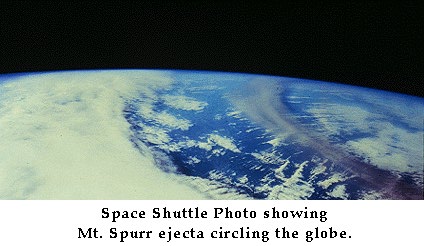
The location of the volcano appears to also be a major factor in determining its large-scale impact. Those erupting in the tropical zones are more likely to spread their haze veils over the largest portion of the planet, and in many cases cover both North and South Hemispheres. Stratospheric-level winds tend to flow from the Equator toward the poles, so sulfur aerosols from equatorial eruptions get spread out over both hemispheres. In the past 200 years, Mt. Pinatubo in the Philippines (June 1991), El Chichon (Mexico, 1982), Mt. Agung (VEI = 5; Indonesia, 1963), Santa Maria (VEI = 6; Guatemala, 1902), Krakatau (Indonesia, 1883), Mt Hudson (VEI = 6, Chile, 1991) and Tambora (1815) all created perceptible cooling events. Major high latitude volcanoes such as Alaska’s Mt Redoubt (VEI = 4) in 2009 and Mt Novarupta, aka Katmai, (VEI = 6) in 1912 did not have global impacts. Laki appears to have been one exception, though no records exist of its impacts in the Southern Hemisphere.
In contrast, for a volcanic eruption in the mid-latitudes or polar regions, the stratospheric circulation in those regions generally moves poleward and sinks. Thus, the volcanic particles are not able to penetrate high in the stratosphere and thereafter spread out around the entire globe.
The great Tambora explosion of 1815 caused major impacts in the Northern Hemisphere known as the Year Without A Summer in both North America and Europe in 1816. (Recent analyses of ice cores from Antarctica and Greenland by researcher from South Dakota State University suggest another major, heretofore unknown, volcano erupted around 1809 that might, in combination with Tambora, explain the extremely cold decade of 1810-1819 — the coldest in at least the preceding 500 years. This 1809 eruption likely was also very large — perhaps half that of Tambora.)
Looking at some of the global temperature reductions of recent volcanic eruptions, we find the 1980 eruption of Mt St Helens lowered global temperatures by 0.1 C degrees (0.18 F degrees) while the much smaller El Chichon eruption of 1982 lowered global them three to five times as much. The reason appears to be that El Chichon eruption emitted a much greater volume of sulfur-rich gases (40 times more) even though Mt St Helens emitted a greater amount of ash into the stratosphere. The cooling impacts of El Chichon may have been tempered by the strong El Niño regime present at the time of eruption.
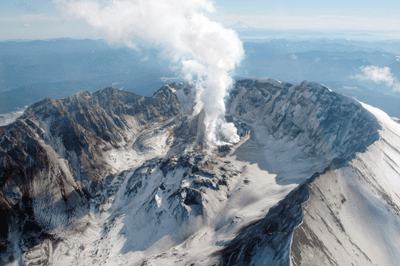
The most well-known “modern” volcanic eruption is that of Krakatau (also spelled Krakatoa) between Java and Sumatra in 1883. It released 20 times the material of Mt St Helens and is the considered the second largest volcanic eruption in history behind Tambora. Global temperature impacts from Krakatau have been estimated as a cooling of 1.2 C degrees (2.2 F degrees) for several years. In addition to the cooling impacts, the Krakatau dust veil produced vivid changes in the sky, particularly the twilight skies. The changes were even noticed in smoke-enshrouded London. Many contemporary artists painted works inspired by the vibrant nature of the sunsets.
Finally, how long a volcano keeps emitting materials in large quantities and to great heights also becomes a factor in determining its influence on weather on all time scales.
Volcanoes also produce impacts on weather and the environment that manifest on shorter time scales and more regional space scales. The thickest ash clouds cover the sky in the region of the eruption and thus reduce local sunlight and temperatures during the day. At an eruptions peak, these dense black clouds can be punctuated by intense lightning, giving a real doomsday feel to the scene.
Volcanic emissions can cause local visibility reductions, which are known as vog (volcanic smog). Vog is a common weather condition downwind of Hawaii’s Kilauea volcano. Vog can cause and aggravate respiratory and vision problems in humans and animals, and, when combined with rain to produce acid rain, can damage crops, corrode metal and leach metal into water supplies.
As Eyjafjallajökull has shown, volcanic clouds can be a hazard to aircraft when the particles in the contaminated air are pulled into their engines. Volcanic ash ingested by jet engines may result in the immediate deterioration of engine performance and engine failure. The deposition of ash in the hot sections of the engine may cause engine failure. If minute glass particles produced during the eruption re-melt when the ash is taken in by the engine and coat fuel nozzles, the combustor, and turbine, it will reduce the efficiency of fuel mixing and restricts airflow through the engine. This can cause surging, flame out, and immediate loss of engine thrust. The ash may also seriously erode engine parts, including the compressor and turbine blades, thus reducing the efficiency of the engine. As a result, warnings are issued by Volcanic Ash Advisory Centers when ash clouds may prove a danger to flights through a region.
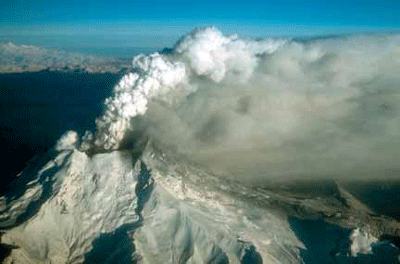
The deposition of volcanic ash onto the land and sea can be either a curse or blessing depending on the composition of the ash. Often there are fluoride compounds in the ash that can contaminate the soil, killing vegetation and grazing livestock. Usually these compounds are washed out quickly from the plume and are mostly a local concern. The beneficial deposition of volcanic ash results from the minerals in the ash fertilizing the surface soil and waters. We now believe that many of the islands in the South Pacific receive life-giving nutrients from long-range atmospheric transport of volcanic ash.
The particles from volcanic ash sent high into the atmosphere by violent eruptions, can remain suspended in the atmosphere for many years and may alter the sky color. An atmosphere filled with such dust at lower elevations (troposphere) will appear much more reddish. Perhaps the myths and folk beliefs fearing blood-red skies grew out of the effects of volcanic dusts on sky color. But when the volcanic haze reaches the stratosphere, twilight skies tend to have a violet hue in their later stage.
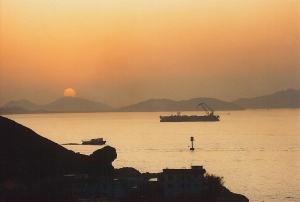
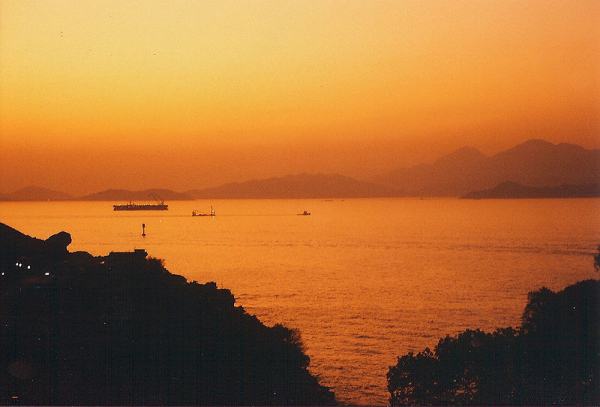
About 15 minutes after sunset (or before sunrise) when the troposphere has entered the Earth shadow and the stratosphere is still illuminated by sunlight passing through it, the high-level haze clouds become visible. Because the effect has its greatest intensity after the sun has set, such twilights are known as afterglows. The afterglow often has a violet or lilac hue because the sunlight’s blue wavelengths are scattered downward by the haze, the blue combines with the reds of sunset passing through the troposphere to given shades of violet.
In addition to changes in the colors of the sky from the volcanic veil, some corona phenomena also become more frequent. In fact, the Bishop’s ring was first described by Sereno Bishop when the Krakatau plume reached Honolulu, Hawaii (though he mistakenly termed it a halo) on 5 September 1883, several days after the eruption of Krakatau on 27 August:
“Let me draw your special attention to the very strange corona or halo that extends about 20 to 30 degrees away from the sun. It could be seen here every day, and the whole day long. A whitish veil with a shade of pink and violet or purple shadow in front of the blue background. I don‘t know any other report on such a corona. It is a hardly remarkable object.”
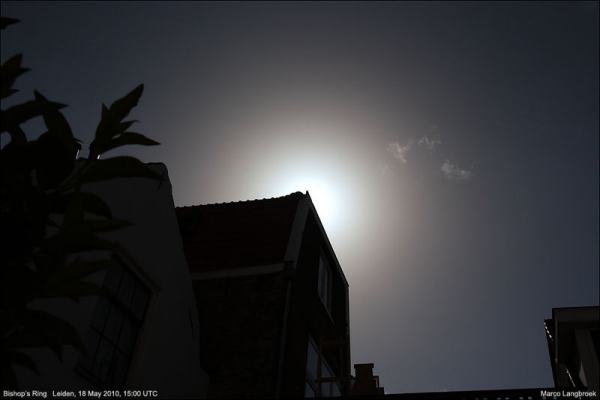
The Bishop’s ring is now defined to have an inner aureole of white or bluish white bounded by an outer ring of reddish, brownish or purple coloration. The area enclosed by the rings, which is usually large — a radius of about 28 degrees — is distinctly brighter than its surroundings.
 |
To Purchase Notecard, |
Now Available! Order Today! | |
 |
 |
Now |
The BC Weather Book: |


